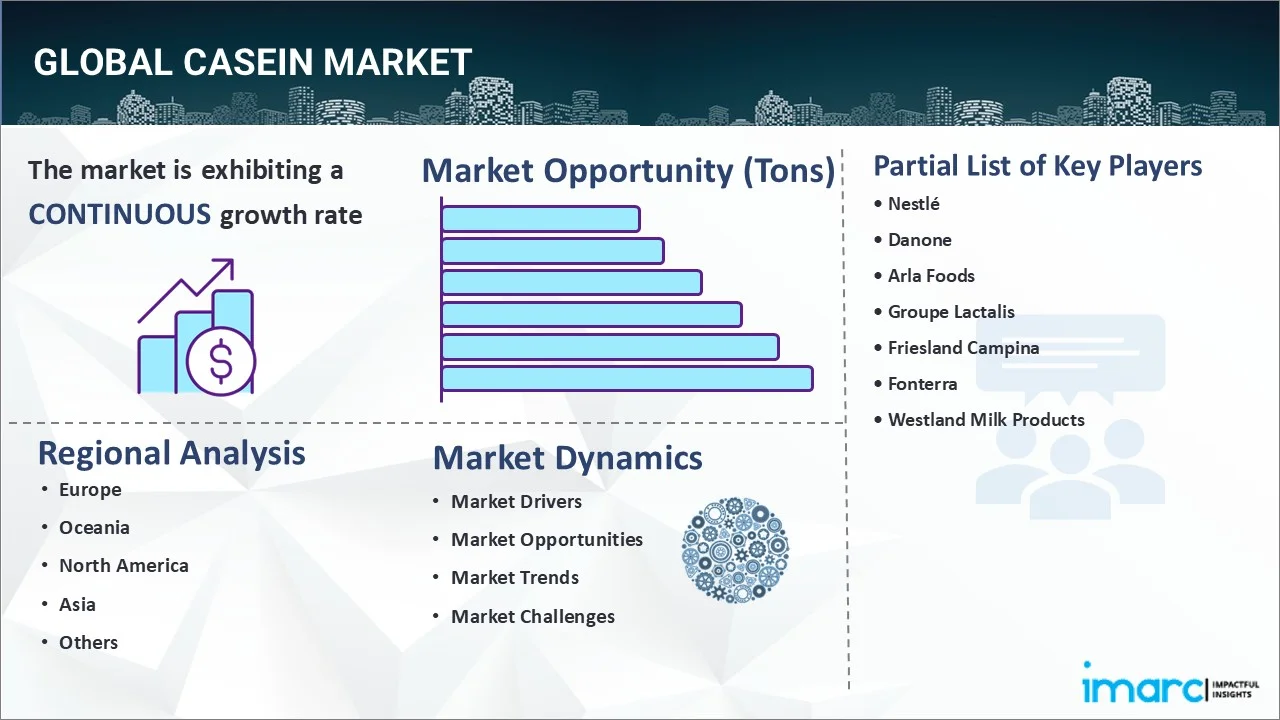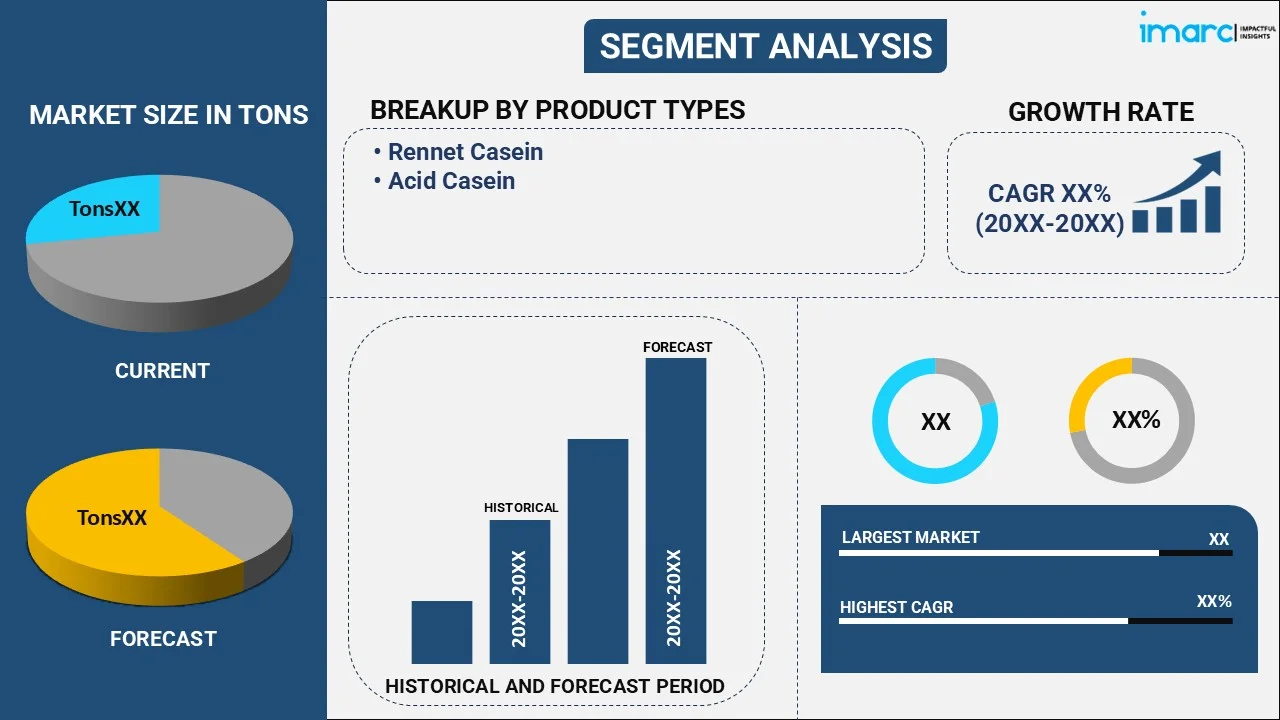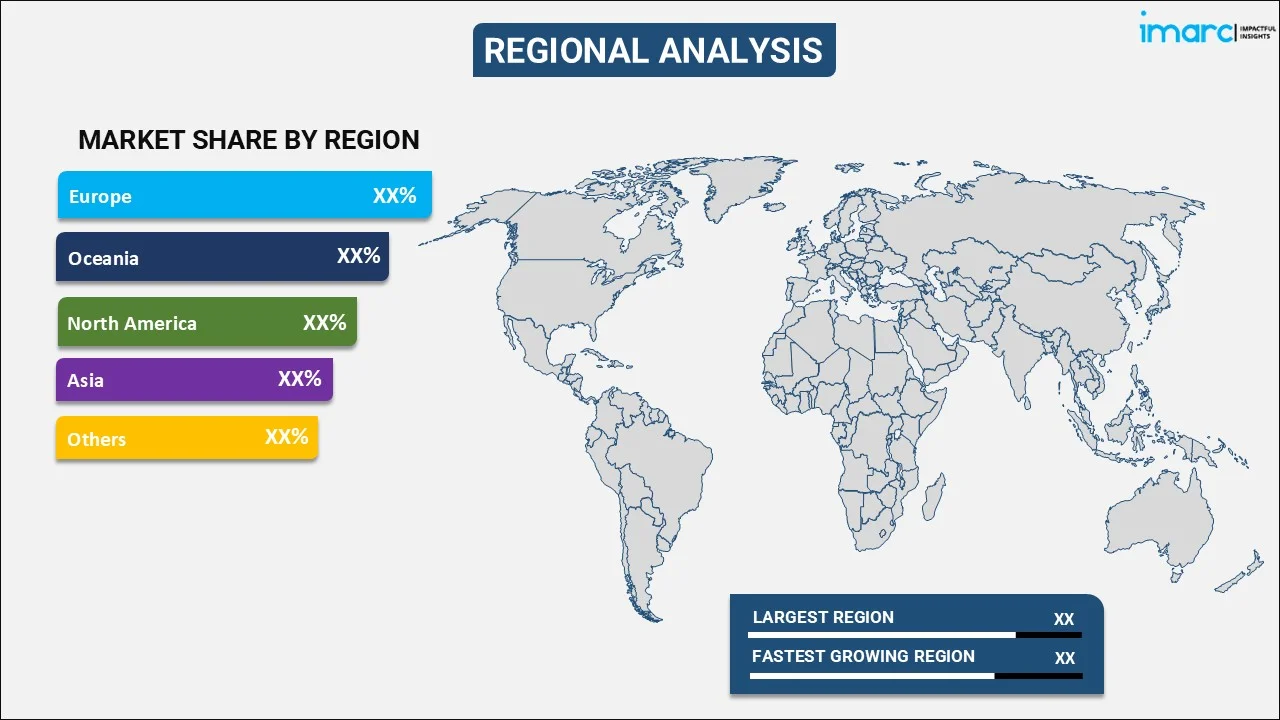
Casein Market Report by Product Type (Rennet Casein, Acid Casein), End Use (Food and Beverages, Pharmaceuticals, Cosmetics, Industrial, and Others), and Region 2025-2033
Casein Market Size:
The global casein market size reached 427.9 Kilo Tons in 2024. Looking forward, IMARC Group expects the market to reach 581.7 Kilo Tons by 2033, exhibiting a growth rate (CAGR) of 3.5% during 2025-2033. The market is experiencing steady growth driven by rising preferences for protein-rich diets to support muscle development, weight management, and overall well-being, ongoing innovations in casein production processes, and the increasing utilization of casein in functional foods.
|
Report Attribute
|
Key Statistics
|
|---|---|
|
Base Year
|
2024 |
|
Forecast Years
|
2025-2033 |
|
Historical Years
|
2019-2024
|
| Market Size in 2024 | 427.9 Kilo Tons |
| Market Forecast in 2033 | 581.7 Kilo Tons |
| Market Growth Rate 2025-2033 | 3.5% |
Casein Market Analysis:
- Market Growth and Size: The market is experiencing stable growth, driven by increasing consumer awareness of protein-rich diets and the demand for dairy-based products.
- Technological Advancements: Research and development (R&D) efforts are leading to the development of innovative casein-based formulations in pharmaceuticals and cosmetics.
- Industry Applications: The market is experiencing high demand from diverse industries, including pharmaceuticals, cosmetics and personal care, and food and beverage (F&B). The pharmaceutical sector, in particular, is witnessing a strong uptake of casein due to its increasing use in tablet formulations to ensure cohesion and integrity.
- Geographical Trends: Europe leads the market, driven by strong dairy industries and high-quality standards. However, North America and Asia are emerging as fast-growing markets, driven by changing consumer preferences and expanding industries.
- Competitive Landscape: Key players in the casein market are known for their quality products and global presence. Additionally, competition is intensifying with the entry of new players offering niche products.
- Challenges and Opportunities: While the market faces challenges, such as fluctuating milk prices, supply chain disruptions, and regulatory compliance in the food industry, it also encounters opportunities in developing new casein-based functional ingredients, exploring emerging markets, and addressing health-conscious consumer demands.
- Future Outlook: The casein market is poised for continued growth on account of evolving consumer preferences for natural and protein-rich products. Moreover, ongoing innovations in casein-based applications, sustainable sourcing, and expansion into untapped regions are expected to propel the market growth.

Casein Market Trends:
Health and Wellness Consciousness:
The increasing health and wellness consciousness among the masses represents one of the primary factors favoring the market growth. In addition, the rising preferences of individuals for protein-rich diets to support muscle development, weight management, and overall well-being are facilitating the market growth. Along with this, the increasing participation of individuals in sports and fitness activities is driving the demand for casein as it provides sustained protein release. In line with this, the incorporation of casein into functional foods and nutraceuticals, capitalizing on its bioactive properties. It is used in products aimed at addressing specific health concerns, such as promoting better sleep or aiding digestive health. Moreover, several functional food manufacturers are continually exploring new culinary innovations that incorporate casein. It is used for its functional properties, such as emulsification, gelling, and texture enhancement, in a wide range of products, including cheese, yogurt, ice cream, and bakery items. Furthermore, the snack food industry is introducing protein-enriched snacks, which is contributing to the market growth.
Growing Interest in Natural and Sustainable Ingredients
The escalating demand for foods and beverages formulated with sustainable and natural ingredients is strengthening the growth of the market. In addition, companies are increasingly focusing on sourcing milk for casein production from sustainable and ethical practices. This includes supporting dairy farms with environment friendly practices and ensuring animal welfare standards. Apart from this, ongoing innovations in casein production processes are aimed at reducing the carbon footprint to promote environmental health. This includes efforts to minimize waste and energy consumption in manufacturing. In line with this, several companies are focusing on sustainable packaging solutions for casein-based products, reducing plastic usage and promoting biodegradable options. In addition, governing authorities and regulatory bodies of several countries are implementing stricter environmental regulations and standards. This encourages companies to adopt sustainable practices to comply with legal requirements. Moreover, many companies are actively working on sustainable packaging solutions for casein-based products to promote environmental health and attract a wider consumer base.
Expanding Food and Beverage Industry Applications
The rising utilization of casein in preparing various foods and beverages is strengthening the growth of the market. Food manufacturers are continually exploring new culinary innovations that incorporate casein. It is used for its functional properties, such as emulsification, gelling, and texture enhancement, in a wide range of products, including cheese, yogurt, ice cream, and bakery items. In addition, the escalating demand for clean label products with natural ingredients is promoting the use of casein in food formulations. It helps improve texture and stability without the need for synthetic additives and aligns with consumer preferences for clean, transparent labeling. In line with this, the continuous rise of functional dairy beverages, such as protein shakes and probiotic-rich drinks, is creating lucrative opportunities for casein incorporation. It enhances nutritional content and contributes to the creamy texture and taste of these beverages. Moreover, rapid globalization of food trends is catalyzing the demand for casein in various international cuisines and products.
Casein Industry Segmentation:
IMARC Group provides an analysis of the key trends in each segment of the market, along with forecasts at the global and regional levels for 2025-2033. Our report has categorized the market based on product type and end use.
Breakup by Product Type:

- Rennet Casein
- Acid Casein
The report has provided a detailed breakup and analysis of the market based on the product type. This includes rennet casein and acid casein.
Rennet casein is a primary category in the casein market, known for its use in various food applications. It is obtained through the precipitation of milk proteins with the use of rennet enzymes or acids. This type of casein is popular for its ability to form stable gels, making it an essential ingredient in the production of cheese. Apart from this, its versatility extends to other dairy products, such as yogurts, and it also finds applications in the manufacturing of processed foods, infant formulas, and protein supplements.
Acid casein is obtained by precipitating milk proteins using acids like hydrochloric acid or citric acid. Acid casein is primarily used in non-food applications, such as the production of adhesives, paints, and coatings. It is valued for its adhesive properties and ability to form a smooth film when dried. Additionally, acid casein is used in cosmetics, particularly in skincare and hair care products.
Breakup by End Use:
- Food and Beverages
- Pharmaceuticals
- Cosmetics
- Industrial
- Others
Food and beverages hold the largest share in the industry
A detailed breakup and analysis of the market based on the end use have also been provided in the report. This includes food and beverages, pharmaceuticals, cosmetics, industrial, and others. According to the report, food and beverages accounted for the largest market share.
The food and beverage (F&B) industry is a significant consumer of casein as it is a valuable source of high-quality protein and is extensively used in the production of cheese, yogurt, protein supplements, and bakery products. Its emulsifying and gelling properties make it an essential ingredient in various processed foods and dairy-based beverages, catering to consumers' demand for nutritious and convenient options.
In the pharmaceutical industry, casein serves various purposes. It is utilized as a binder in tablet formulations, providing cohesion and stability to medications. The slow-release properties of casein also make it valuable in drug delivery systems, ensuring controlled release of active ingredients. Moreover, it is used in nutraceuticals and infant formula, contributing to the health and well-being of consumers.
Casein finds applications in cosmetics and personal care products. Its film-forming and moisturizing properties make it suitable for skincare creams, lotions, and hair care products. Casein-based cosmetics are appreciated for their ability to improve skin texture and provide hydration, appealing to consumers seeking natural and effective beauty solutions.
In the industrial sector, casein is used for non-food applications. It serves as a key component in the formulation of adhesives, paints, coatings, and glues due to its adhesive and binding properties. Casein-based industrial products are valued for their ability to create strong and durable bonds, making them essential in various manufacturing processes.
Breakup by Region:

- Europe
- Oceania
- North America
- Asia
- Others
Europe leads the market, accounting for the largest casein market share
The market research report has also provided a comprehensive analysis of all the major regional markets, which include Asia, North America, Europe, Oceania, and others. According to the report, Europe accounted for the largest market share.
Europe is a significant market for casein, primarily due to the thriving dairy industry in countries like France, Germany, and the Netherlands. These nations are known for their high-quality dairy products, contributing to a substantial demand for casein. The health-conscious European consumers also drive the market, as casein is a valuable source of protein.
Oceania, particularly Australia and New Zealand, are the emerging leaders in the casein market. These countries are known for their robust dairy farming practices and stringent quality standards. The efficiency of the dairy industry in Oceania ensures a steady supply of high-quality casein products to both domestic and international markets.
North America, with the United States as a key player, has a growing demand for casein. The increasing interest in protein-rich diets and the presence of various food and beverage manufacturers contribute to the growth of the market. North America also has a substantial market for sports nutrition products containing casein.
Asia is emerging as a promising market for casein, driven by the rising middle-class population and changing dietary preferences. Countries like China and India are witnessing increased consumption of dairy products, including those containing casein. Additionally, the expansion of the food processing industry in Asia is further driving the demand for casein.
Leading Key Players in the Casein Industry:
The key players in the market are investing in R&D activities to create innovative casein-based products. They are developing formulations that cater to changing consumer preferences, such as organic and plant-based casein alternatives. These innovations help them stay competitive and meet evolving market demands. Additionally, many major players are expanding their global reach by entering new geographical markets. They are establishing partnerships and distribution networks to increase their presence in regions with growing demand, such as Asia and North America. Moreover, they are emphasizing sustainable sourcing of raw materials, reducing carbon footprints, and adopting eco-friendly production practices. Furthermore, they are increasingly offering customized casein solutions to cater to specific industry needs. This includes tailoring products for pharmaceutical formulations, industrial applications, and unique food products.
The market research report has provided a comprehensive analysis of the competitive landscape. Detailed profiles of all major companies have also been provided. Some of the key players in the market include:
- Nestlé
- Danone
- Arla Foods
- Groupe Lactalis
- Friesland Campina
- Fonterra
- Westland Milk Products
(Please note that this is only a partial list of the key players, and the complete list is provided in the report.)
Latest News:
- July 2023: Fonterra launched anchor cheddar cheese. It is a block shape variant that offers savory taste and, the cheese can be grated, sliced, or even cut into other shapes according to preference.
- April 2023: Arla Foods launched Nutrilac Protein Boost to meet the growing consumer focus on nutrient quality. It provides high protein content, delivers a clean, neutral dairy taste, with low viscosity, high solubility, and a pleasant mouthfeel.
Casein Market Report Scope:
| Report Features | Details |
|---|---|
| Base Year of the Analysis | 2024 |
| Historical Period | 2019-2024 |
| Forecast Period | 2025-2033 |
| Units | '000 Tons, Million USD |
| Scope of the Report | Exploration of Historical and Forecast Trends, Industry Catalysts and Challenges, Segment-Wise Historical and Predictive Market Assessment:
|
| Product Types Covered | Rennet Casein, Acid Casein |
| End Uses Covered | Food and Beverages, Pharmaceuticals, Cosmetics, Industrial, Others |
| Regions Covered | Europe, Oceania, North America, Asia, Others |
| Companies Covered | Nestlé, Danone, Arla Foods, Groupe Lactalis, Friesland Campina, Fonterra, Westland Milk Products, etc. |
| Customization Scope | 10% Free Customization |
| Post-Sale Analyst Support | 10-12 Weeks |
| Delivery Format | PDF and Excel through Email (We can also provide the editable version of the report in PPT/Word format on special request) |
Key Benefits for Stakeholders:
- IMARC’s industry report offers a comprehensive quantitative analysis of various market segments, historical and current market trends, market forecasts, and dynamics of the casein market from 2019-2033.
- The research report provides the latest information on the market drivers, challenges, and opportunities in the global casein market.
- The study maps the leading, as well as the fastest-growing, regional markets.
- Porter's five forces analysis assists stakeholders in assessing the impact of new entrants, competitive rivalry, supplier power, buyer power, and the threat of substitution. It helps stakeholders to analyze the level of competition within the casein industry and its attractiveness.
- The competitive landscape allows stakeholders to understand their competitive environment and provides insight into the current positions of key players in the market.
Key Questions Answered in This Report
The global casein market reached a volume of 427.9 Kilo Tons in 2024.
The global casein market is expected to exhibit a CAGR of 3.5% during 2025-2033.
The outbreak of the coronavirus disease (COVID-19) and the increasing adoption of social distancing measures in numerous countries have disrupted the supply chain and market operations of the industry.
Casein is used to emulsify fat, provide nutrition, and as an adhesive and colorant. This has led to an increase in the demand for casein from a wide variety of industries, such as food and beverage, and pharmaceutical.
One of the major trends in the casein industry is the growing demand for protein-based food products among consumers, on account of rising health consciousness and fitness trends.
Based on the product type, the market is bifurcated into rennet and acid casein.
One the basis of the end use, the market has been classified into the food and beverages, pharmaceuticals, cosmetics, industrial and other sectors. Among these, casein is mostly used in the food and beverages industry.
Region-wise, Europe holds the leading position in the market. Other major regions are Oceania, North America, and Asia.
The leading players operating in the industry are Nestlé, Danone, Arla Foods, Groupe Lactalis, Friesland Campina, Fonterra, Westland Milk Products.
Need more help?
- Speak to our experienced analysts for insights on the current market scenarios.
- Include additional segments and countries to customize the report as per your requirement.
- Gain an unparalleled competitive advantage in your domain by understanding how to utilize the report and positively impacting your operations and revenue.
- For further assistance, please connect with our analysts.
 Request Customization
Request Customization
 Speak to an Analyst
Speak to an Analyst
 Request Brochure
Request Brochure
 Inquire Before Buying
Inquire Before Buying




.webp)




.webp)












